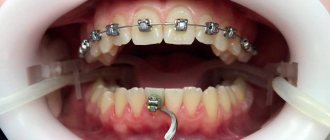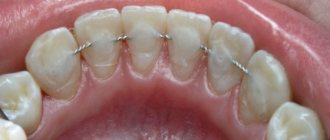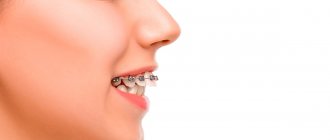This is a headache and a nightmare for any orthodontist: a patient who has had his braces removed and given a removable retainer and instructions for its use returns after some time with complaints about the curvature of his previously straight teeth. The retention period is the most psychologically difficult part of the treatment. Everything is already perfect, and then you have to wear a retainer. Yes, there are other reasons for the unsuccessful outcome of the correction. And although they are much less common, let’s talk about them in more detail.
Correction principle
The method of correcting malocclusion with braces is based on the principle of creating constant pressure on the teeth. Under pressure, the tooth root begins to press on the socket on one side, thereby causing rarefaction of the bone tissue. In the direction of rarefaction, the tooth moves. On the other side of the hole, bone tissue, on the contrary, grows. Thus, after a certain period of time, not only the position of the tooth changes, but also the shape of the socket, which prevents the tooth from returning to its original place.
Correct your bite or dental defect with invisible aligners Find out what it is
Bone tissue grows quite quickly, but it takes quite a long time to “ripen”. That is why, after finishing wearing the brace system, a removable retainer is made for the patient for another year or two or a splint is installed on the incisors and canines. Additional fixation during the retention period helps to avoid repeated tooth curvature.
Negative consequences of wearing braces: common myths
Is there life after braces? At the very beginning of the journey (that is, orthodontic treatment), the answer to this question seems to be negative. But the cherished hour is getting closer and closer, in which the shackles (that is, braces) will fall, and the world will see your even, dazzling smile. But will everything be so optimistic? Let's look at the typical fears that sometimes plague owners of braces.
Complications after braces
Complications after braces are possible and, like any complications, quite unpleasant. This may be recession (that is, drooping) of the gums, disruption of the integrity of the neurovascular bundle, resorption of the roots, etc.
We will try to reassure you: firstly, although these are sad, but infrequent situations - for example, gum recession is observed in only 4% of patients, and this is the most common complication. Secondly, many problems are associated with excess pressure on the teeth, that is, with an incorrectly calculated load on the braces. If you have chosen an experienced, professional doctor, then most likely you will not face such troubles. To be on the safe side, you can take a panoramic photo once every six months that will show all the current changes.
Harm from braces
Harm is too strong and broad a word: everyone can understand something different by it. Here are the most common causes of distress in those who remove braces. First of all, this is a change in the color of tooth enamel. In most cases, hygienic cleaning of the tooth cavity and patience help: about a month after removing braces, the tone of the enamel evens out. You can also talk to your doctor about the suitability of whitening procedures.
It happens that girls complain about changes in the oval of their face. Not all orthodontists agree that it is braces that make the face thin and seem longer. Nevertheless, this opinion exists among patients. Whatever the reason for the changes, special face gymnastics will help. By the way, it will also be a good prevention of aging.
After braces, teeth become crooked
Curvature of teeth after braces can theoretically (!) happen to anyone, and here’s why. The even bite you have achieved, although it looks very natural, is actually not so. And after you remove the braces that hold your teeth in the correct position, they will immediately try to return to their original places. But these same “old places” are no longer there: the bone tissue has been rebuilt, the blood vessels, ligaments and soft tissues have moved... So there is nowhere for the teeth to return. Therefore, they can simply move anywhere - and the result will be even more disastrous than it was before the installation of the orthodontic system.
But in fact, such a sad option is practically excluded for most patients. It awaits you only if you do not listen to your doctor and refuse to install retainers - special devices that can permanently keep your teeth in the correct position.
Gaps between teeth after braces
This is also theoretically (!) possible. The reasons are the same as in the case of crooked teeth. After braces, they try to return to their usual place, but it turns out to be occupied. As a result, the teeth stand up as they please and, as one of the consequences, a gap forms between the teeth. Installing retainers will help to avoid such developments.
Braces give me headaches
Headache, just like, for example, muscle pain, can really become a companion to braces. Everything in the head is located quite close, and the impact on the structures in the maxillofacial area, namely the installation of even the most expensive braces, can affect other organs. Pain is always an SOS signal from the body. And you shouldn’t tolerate it; be sure to consult your orthodontist. And also, see a neurologist: headaches can have many causes that have nothing to do with orthodontic treatment.
Expert opinion
“Orthodontic treatment of a bite to achieve a beautiful smile is a complex process: any patient can understand this by how carefully the brace system is installed, how often its elements have to be adjusted and how expensive it is. It is quite natural that some difficulties may arise, both directly during treatment and after removal of the orthodontic apparatus.
I can advise anyone who decides to have it installed, first of all, to be very careful in choosing their attending physician. Only the high professionalism of an orthodontist can provide you with excellent results - a correct bite and a beautiful smile. Your teeth should not become a field for experiments by an unqualified specialist - let me remind you that you pay a lot of money for his work and trust him with your health and appearance!
Also, be proactive and caring: if you have a question, ask your doctor, not your neighbor or a “more experienced” braces wearer. And if you have found “your” orthodontist, then carefully follow all his recommendations - this will protect you from many problems.
Also keep in mind that your communication with your doctor will not end after the bite is corrected: you will have a very long (about twice as long as you wore braces) period of retention - that is, maintaining the result. Orthodontic devices of this period are called retainers; they are easy to care for and almost invisible in the mouth. They are the ones who will help you avoid disappointments and complications after removing braces.”
Possible problems after removing braces
Some people's teeth diverge quickly after completing the correction stage. During the first year, some individuals may only slightly rotate around their axis. Everything is individual, but some general patterns can be identified.
Fanned teeth
A rapid relapse after braces are removed may be due to the following factors:
- Refusal of retainers. Patients often refuse permanent retainers because their installation damages tooth enamel. And it’s annoying to wear removable retainers, even those that are worn only at night. As a result, the teeth return to their previous position, since the new position has not yet been “overgrown” with bone tissue.
- Individual characteristics. There are people in whom new formation and “maturation” of bone tissue proceeds faster than others. And there are those for whom this process is delayed. For some, the displacement of teeth in order to correct the shape of the dentition was insignificant, while for others the tooth “came a long way” before taking its place in the dentition. Teeth quickly “huddle together” after crowding is eliminated. The teeth, which were mixed with braces around their axis, easily turn back.
- Breakage of braces, use of a system of inadequate quality. If the pressure on the teeth during correction was not constant, then the likelihood of an unfavorable outcome increases. You shouldn’t walk around with a broken arch or unstuck locks for a week. It is better to see a doctor on the same day. This will save you from many problems.
- Tooth extraction. When there is not enough space for teeth in the dentition, the orthodontist may decide to remove the “extra” ones. Most often these are fours, eights, less often sixes. The absence of fangs can cause the formation of a diastema. Removing a six causes significant displacement of adjacent teeth.
Loose teeth after braces
Occurs infrequently. In most cases, the feeling of excessive tooth mobility after removing braces is deceptive. It may appear at the very beginning of the retention period and disappear on its own and without treatment. It's another matter if the teeth are really loose. In this case, it is better to seek help from a specialist.
Pain in the teeth and gums
There may be some discomfort after removing braces. Pain occurs especially often after eating solid foods. The reason for this is a change in the condition of the ligaments that hold the roots of the teeth, as well as an increase in the sensitivity of the enamel if the remineralization procedure was not carried out. Reducing the chewing load and using special medications that reduce the sensitivity of teeth and gums help reduce pain.
How to maintain the results of orthodontic treatment for a long time?
The doctor removes the braces when the teeth are in the desired position. After this, the patient is usually sent for professional cleaning and removal of tartar. Metal structures make it difficult to clean the enamel, so during long-term orthodontic treatment, hard deposits often remain on it.
After professional oral hygiene, the doctor selects removable or non-removable structures for the patient that will record the results of treatment and prevent the teeth from moving apart again. Depending on the initial position of the canines and incisors, the duration and complexity of the bite correction, the orthodontist may recommend:
- permanent or temporary wearing of mouth guards,
- installation of retainers.
The mouthguard is usually a removable cover made of transparent plastic. It is made from an individual impression so that it accurately matches the shape of the patient’s jaw. A properly selected mouthguard does not affect diction and does not cause pain or discomfort. The patient can remove, put on and clean it independently. The orthodontist will tell you how often and for how long you need to wear a mouthguard. Immediately after removing the braces, doctors advise wearing them at night and for several hours during the day. Over time, when the teeth get used to the correct position, you can do this less often.
A permanent retainer is a thin steel wire that is attached to the back surface of the incisors and canines. It prevents them from moving apart, thereby preventing the gap from reappearing. The non-removable design is not noticeable during a conversation or when smiling, and does not interfere with chewing food or talking. The doctor secures the arch with glue or composite materials that do not adversely affect the condition of the enamel.
Some patients have to wear a retainer for life, while others may have to remove it after a few years. The timing depends on the age at which the bite correction was performed and the initial position of the teeth.
What is the correct name for the gap between the front teeth?
What we call a gap, in the language of dentists, sounds like a diastema (diastema - translated from Greek - interval, distance).
One way or another, diastema occurs in almost every fifth adult on the planet and in every second child with baby teeth. Diastema is an abnormally large space between the upper or lower central incisors of the dentition. Its dimensions can vary from 1 to 10 mm. But most often cracks occur within 2-6 mm. Do not confuse diastema with tremata, which form anywhere in the dentition, with the exception of the central incisors.
Why does diastema develop?
There are many factors influencing the development of pathology. The main ones are the following:
- Hereditary predisposition. If parents have such a problem, then the likelihood of it developing in children is also high.
- Partial edentia (lack of teeth).
- Diastem is an incorrect (low) attachment to the lips of the frenulum (upper and lower).
- Removal of a tooth from the front row and the prolonged absence of a prosthesis in its place, which leads to their displacement and closing of the void, forming new gaps.
- Abnormal shapes and sizes of lateral incisors.
- Periodontal pathologies.
- The habit of gnawing anything leads to improper growth.
- The presence of bad habits in infancy (long-term fascination with pacifiers, constant desire to chew something, etc.)
Gap between front teeth photo.











